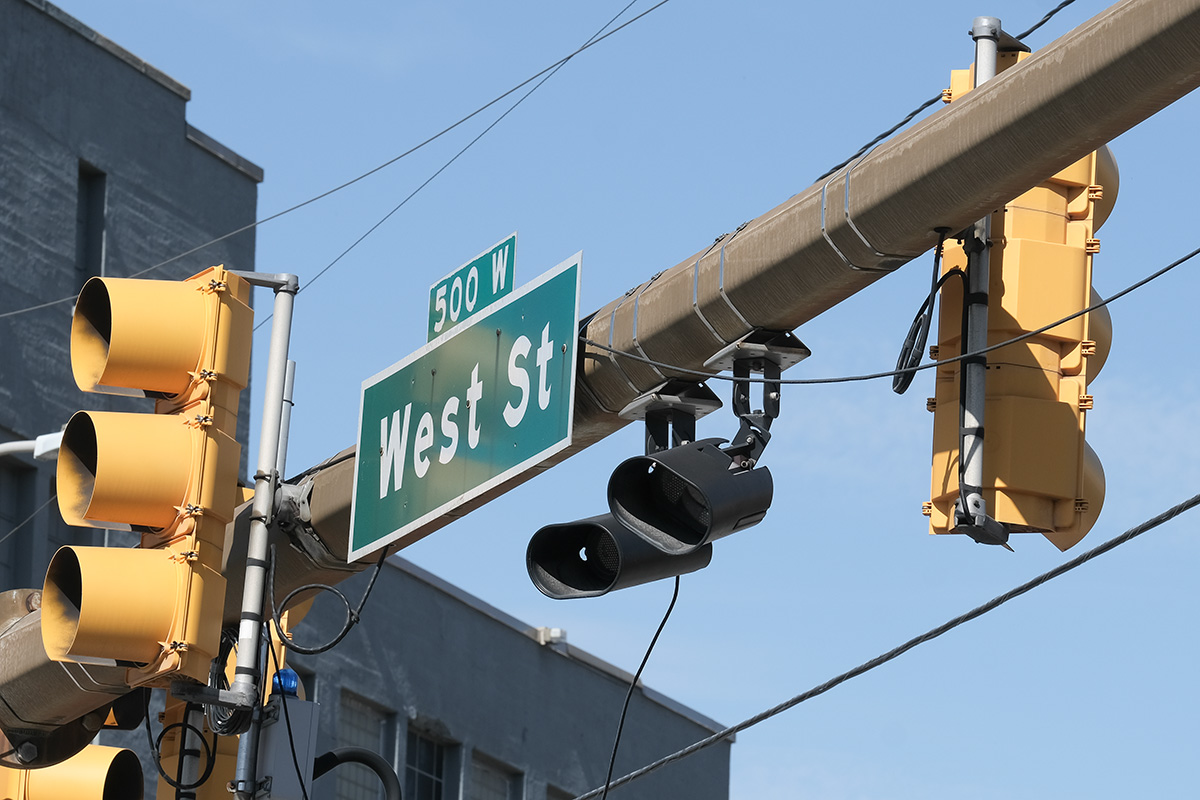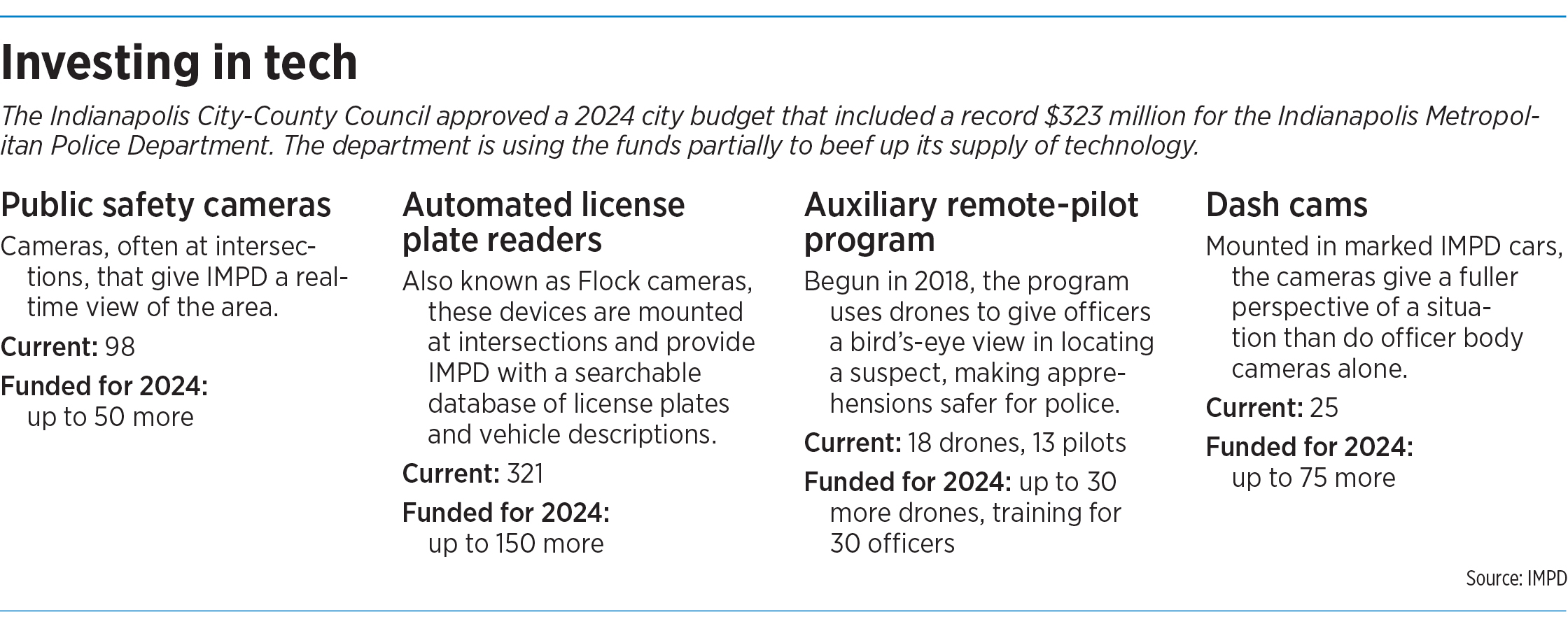Subscriber Benefit
As a subscriber you can listen to articles at work, in the car, or while you work out. Subscribe NowWhen a Dutch soldier was killed in downtown Indianapolis last August, surveillance footage helped police find the suspect within four days.
Touting that and other times surveillance was effective, the Indianapolis Metropolitan Police Department is poised to invest $9 million in COVID-19 recovery funds into cameras and other technology, even as some critics raise privacy and efficacy concerns. Others say the city hasn’t adopted the new techniques quickly enough.
IMPD is among departments across the country that received an influx of money for technology through the federal American Rescue Plan Act, a stimulus and pandemic relief plan passed by Congress in 2021.
“It’s not the silver bullet, but it does give law enforcement—and particularly as we continue to face staffing challenges—the ability to manage police more effectively and efficiently,” Deputy Chief of Police Kendale Adams told IBJ.
The department currently employs nearly 300 fewer officers than the 1,843 it’s budgeted to have.
Pandemic relief funds are slated to be used for digital evidence software, license plate readers, portable radios, community cameras, gunshot detection equipment and upgrades to the department’s six real-time crime centers.
The technology is meant to help in a host of matters, whether traffic collisions, hit-and-runs or homicides, Adams told IBJ.

The investments have been guided by Indianapolis Mayor Joe Hogsett’s administration. But his Republican challenger for mayor in the Nov. 7 election says the technology has come too slowly to IMPD.
Mark Bode, spokesman for Hogsett’s office, pointed to IMPD’s record $323 million budget for 2024 and investments in b-link cameras, mobile public safety cameras and license plate readers as evidence of progress.
“Mayor Hogsett has prioritized investment into IMPD technology, which has boosted the effectiveness of law enforcement and helped solve countless cases,” Bode wrote in an email. “New technology remains a key part of his 3-year, $150 million violence reduction strategy. … It also includes transparency measures like body-worn cameras or upcoming dashboard cameras.”
Hogsett is running for a third term against Republican Jefferson Shreve, who argues that the city is behind other communities in adopting new technology. For instance, he noted that IMPD currently only has 25 dashboard cameras. The 2024 budget includes funding for 75 more.
“The Hogsett administration has always been a late adopter. We trail in innovation and implementation,” Shreve wrote in an email to IBJ. “When I’m mayor, we will do better. We’ll be more innovative and more nimble in adopting the tech tools that are necessary to provide for our public safety. This will be increasingly important in an environment where we have fewer young people entering the policing profession.”
The American Civil Liberties Union agrees that police body and dash cameras can serve as a much-needed police oversight tool at a time of a growing recognition that the United States has a real problem with police violence. But it says good policies must be in place to prevent invasions of privacy.

Katie Blair, director of advocacy and public policy at the Indiana ACLU, said the organization believes the increasing use of other types of surveillance technologies by local police, especially in neighborhoods of color, can create oppressive and stigmatizing environments. Police agencies must be accountable and transparent for the technology they use, Blair said.
“Before any of these tools are ever purchased, deployed or anything like that, we want to make sure that the community has had a chance to really learn about what these technologies mean and give meaningful input,” Blair said.
Adams told IBJ that the department has spoken with the ACLU about their privacy concerns.
The department tries to be as transparent as possible when it comes to the technology it implements, he said. The police agency has held six meetings in neighborhoods to explain the smart policing technology.
But critics say similar technology has been used inappropriately in other places.
In Detroit, a program called Project Green Light that uses facial recognition to aid law enforcement has led to the wrongful arrest of at least three people. That list includes a pregnant woman who was arrested at her home and charged with carjacking and robbery after an automated facial recognition search, according to The New York Times. She has since filed a lawsuit for wrongful arrest against the city of Detroit.
IMPD’s cameras do not use facial recognition technology, Adams said. Most cameras are placed at major intersections, he said, and not in specific neighborhoods. The placement is based on historical crime data.
“While there are those concerns about government and intrusion, I think we also have to balance that with people who live in fear every day because there’s gunshots, there’s people in their neighborhoods that are shooting,” Adams said.
Shreve, who promotes an increased usage of police technology in his public safety plan, said in a statement that he is committed to ensuring the city protects residents’ right to privacy. Much of today’s policing technology, like body and dash cameras, increase IMPD transparency, he added.
Blair said that studies haven’t yet demonstrated that surveillance cameras reduce crime.
Chris Staab, president of the Near Eastside Community Organization, said a safer community is worth the increased surveillance. He’s been with the organization for 15 years and has lived on the near-east side for 34 years. “At this point, the more surveillance we have, I think, the better off the community is,” Staab told IBJ.
In some ways, the state of Indiana is not surveillance-friendly.
Traffic enforcement cameras are outlawed by the state. The exception is a pilot program that passed into law this year that placed cameras in highway work zones. Those cameras automatically ticket drivers exceeding 11 miles per hour above the speed limit.
As IMPD expands the presence of its own cameras, a state law that creates a 25-foot buffer zone between bystanders and police is being challenged in a lawsuit by some media companies that allege it violates the First Amendment by severely limiting the media’s ability to document and monitor police activities.
Emerging technology
Indianapolis may soon implement a gunshot detection system. The devices are perched on buildings and telephone poles, use acoustic sensors to triangulate the approximate location of a gunshot and notify local police.
In September 2022, the department tested gunshot detection systems from three different companies: ShotSpotter, J & M Security Systems and Flock Safety.
The companies allowed the city to test the equipment free of charge until a permanent vendor is selected. The results are part of a confidential study that is being used to select the final vendor. The department will use the American Rescue Plan Act funds to pay for equipment.

Jeremy Carter, executive associate dean at IUPUI’s Paul H. O’Neill School of Public and Environmental Affairs, worked on the study. Generally, Carter said, research on the effectiveness of gunshot detection improving response times is hazy.
The technology is effective at identifying gunshots, Carter said, but false positives do happen. Across the country, he said, the technology adds a burden for police when they are dispatched but cannot find bullet shells in the pinpointed location as proof of a shooting.
“So you add that on top of all the other demands that police patrol requires, and you’re taking limited bandwidth, and they make it even more limited,” Carter said.
On privacy, Carter said although there are technologies that push the boundaries across the country, IMPD isn’t implementing them.
Adams said the results for the gunshot detection tests have been mixed. The technology improved police response times by a few minutes, and in at least one instance, police received the gunshot detection alert before receiving the 911 call.
“In certain communities where gunfire is prevalent, they don’t call 911,” Adams said. Use of the technology has put officers into the neighborhood interviewing residents, which he said might foster better relationships with people affected most by gun violence.
The gunshot detection devices were used in Staab’s neighborhood. He said there was at least one instance in which a life was saved thanks to the gunshot detection system. He said an ambulance arrived more quickly than it would have if it had been sent only after someone called 911.
IMPD’s decision to test the technology is a positive step, Staab said. It allows the department to determine the best technology and gain input from departments in other cities along the way, he said.
“We haven’t rushed into anything, and we’re still kind of analyzing to see what’s what,” Staab said.

Using AI
Another technology, artificial intelligence gun detection, is beginning to be used in Indianapolis but not yet directly within IMPD.
An Indianapolis-based security company, Watchmen Security, recently tested a program that gives cameras the ability to use artificial intelligence to identify guns.
The software was created by ZeroEyes as part of a partnership dubbed the “OneWatch” program.

Austin Smith, the CEO of Watchmen Security, said the technology can be used on all types of cameras to identify instances in which individuals are brandishing guns.
After the AI detects a gun, the image is instantly shown on screens at Watchmen’s command center, which monitors nearly 3,000 cameras across the city of Indianapolis, according to Smith.
A geo pin is dropped at the location, and analysts at Watchmen alert local public safety agencies.
IMPD Northwest District Commander Lorenzo Lewis and Indianapolis City-County Council Majority Leader Maggie Lewis attended a demonstration of the AI gun detection Oct. 10.
The department released a statement following the demonstration saying that the relationship between IMPD and Watchmen Security predated the AI gun detection technology.
The privately owned security company would share information with IMPD’s real-time crime center regarding suspicious or criminal activity.
“IMPD appreciates the on-going relationship with Watchmen Security and will continue to partner with third parties to enhance public safety for Indianapolis,” the statement said.
The first alarm using the AI gun detection technology went off the night of Oct. 19, Smith said.
Watchmen Security will soon begin pitching the use of AI gun detection to faith-based communities and community development corporations, Smith said. But as the technology proves itself, the second step would be to pitch the concept of a one-year pilot program to the city of Indianapolis.
But before IMPD enters into any agreements with any organization offering new technology, civil rights advocates ask that the department consider potential issues.
“Law enforcement oftentimes gets excited about using these new tools without thinking about the unintended consequences of that,” Blair said.•
Please enable JavaScript to view this content.


I continue to be fascinated by this , or similar, use of Covid Relief funds.
Indy is UNSAFE!
Also, don’t spend money to make it safer…
Fascinating when these devices are installed in middle-upper income areas they are called out for only protecting rich people. When installed in lower-challenged area they are punitive devices. The biggest joke is how these groups are turning anti body-camera because the lens doesn’t reveal what they have been spouting about all these years. Turns out the cops are mostly correct.
well – minus the multiple officers currently pleading guilty for abusing their power.
It is more likely that everyone is guilty than that everyone is innocent.